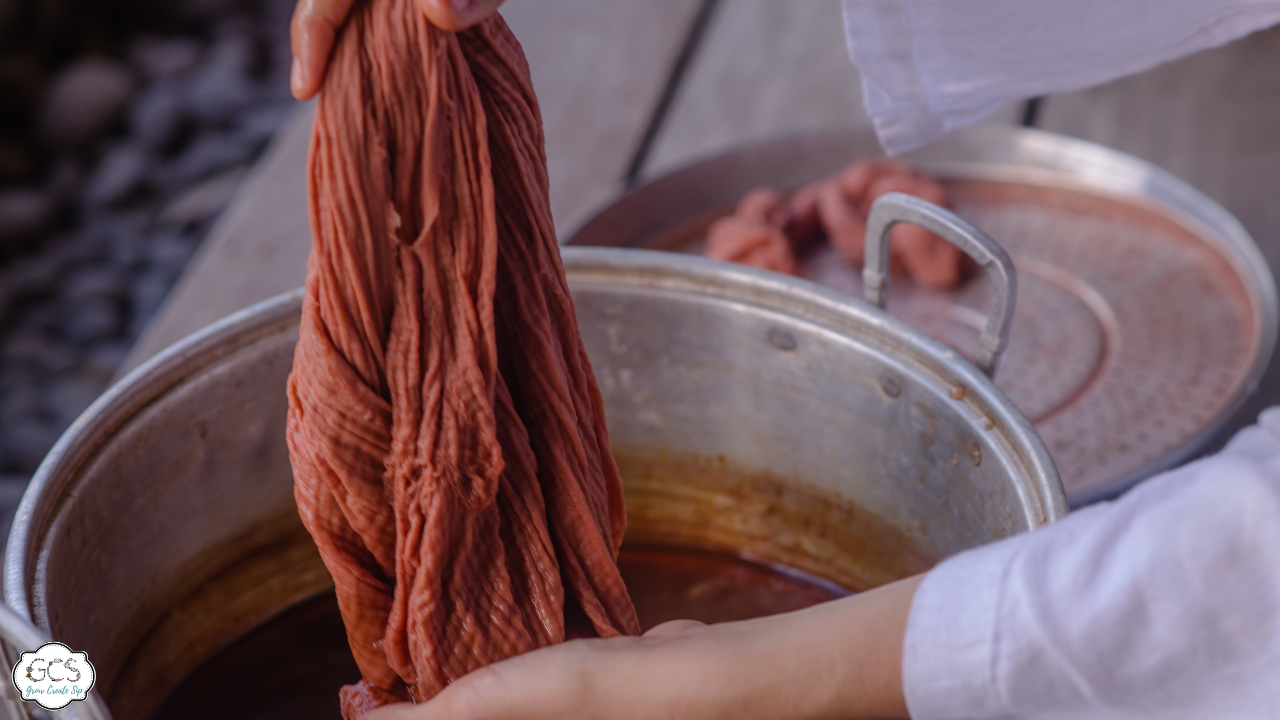How to Use Natural Dye for Fiber, Crafting, and Cooking
Mar 25, 2025
Food dyes have been front and center in the news lately because of the harmful side effects they have on our bodies. The dye known as Red 3 has even been linked to cancer! It’s important to keep chemicals like these out of our diet.
We’ve got some good news for you, though… You can make your own dye at home, meaning you won’t ever need to buy synthetic food dye again! Natural dyes are easy to make, fun to use, and are full of decades of tradition. Using God’s creations to bring color to our foods and crafts is not only practical but a lot of fun! These dyes have also been used historically for decades.
Did you know you can make natural dyes from plants, herbs, minerals, and tea? This guide will teach you which items to use to achieve the beautiful colors that you want. You’ll also learn about different ways to use your natural dye. Whether you’re looking to make natural Easter egg dye or natural clothing dye, you’ll be sure to love the creative and colorful results.

The Legal Stuff
This blog is provided by St. Fiacre's Farm LLC for informational purposes only. It does not constitute medical advice, and you should always seek the advice of a qualified healthcare provider for any medical questions or concerns. These statements have not been evaluated by the Food and Drug Administration. This product is not intended to diagnose, treat, cure, or prevent any disease. Please note that we may earn a small commission on any purchases you make through our affiliate links, at no additional cost to you. Thank you for your support!
What is Natural Dye?
These colors come from naturally occurring materials like flowers, plants, herbs, and minerals. One of our absolute favorite traditions is decorating Easter eggs with natural food coloring! Other popular ways to use natural dyes include cooking, dyeing fibers, making handmade paper, and preparing drop cloth to sew with.
Natural Dyes from Plants: What You Can Use
If you’re making dye to color fabric, it can help to add mordants (such as iron or copper). Mordants bind the dye to fabric and also influence the final color. However, most mordants are not edible, so be sure to only use them for non-food-related purposes. Later on in the post we will cover which kind of mordants are best for which applications.
To get the best results, use materials that have the same color as your desired color. Here are some of the most popular materials used to make natural dyes from plants:
Turmeric
Turmeric is our go-to for yellow shades. Using a little bit of turmeric will give you a light yellow, but you can get a deeper golden color with hints of orange by adding more.
Hibiscus
Use hibiscus tea to make your own dye with a gorgeous pink hue. Look for darker red flowers for the best color. Lighter pink hibiscus flowers will actually produce golds and tans.
Cabbage
Purple cabbage (or red cabbage) is a popular choice for making natural dyes! With chopped cabbage as your main ingredient, you’ll get a stunning blueish-purple-colored dye.
Onion Skins
You’ll love the earthy colors you get when using onion skins to make dye, ranging from yellow to brown to orange — depending on which type of onion you’re using.
Algae
Algae-based dyes can vary in color depending on the type, but reds, greens, and browns are some of the most common colors for this plant-based dye. Algae-derived pigments, such as chlorophyll (green), anthocyanin (red, purple, blue), xanthophyll (yellow), beta-carotene (orange), and phycocyanin (blue), are utilized as natural dyes in various applications.
Red and Blue Berries
You can use red berries to achieve a number of different colors including pinks, reds, and purples. Berries commonly used for natural dyes include blueberries, blackberries, mahonia berries (Oregon grape), red elderberries, and sumac berries. Blueberries will result in beautiful blue or purple shades.
Avocado Pits and Skins
Instead of tossing the pits and skins, use them to make dye! Both the pits and skins of avocados can be used to achieve colors like pink, peach, and tan.
Flowers
Aside from hibiscus, there are other edible flowers commonly used for natural dyes, including marigolds, calendula, hibiscus, roses, and chamomile.
Herbs
Herbs commonly used for natural dyes include yarrow, agrimony, amaranth, dyer's chamomile, chicory, and larkspur.

Using Tea as Natural Fabric Dye and Beyond
Natural Easter Egg Dye
Here on the farm, we love to hide eggs on Easter as a representation of Mary Magdalene looking for Christ after He rose from the tomb. Eggs represent new life — like the life that Christ gave us when He rose from the dead.
This is just one way that we celebrate Easter: by using beautifully decorated eggs! In Ukraine, they hand paint eggs, which are called Pysanky Eggs. Making Easter egg dye from tea is easy and takes only a few simple steps. Once you’ve finished brewing your loose-leaf tea, use a strainer to remove the solids so that you’re left with just the liquid. Then, gently add the eggs in and let them sit until they are colored. For darker colors steep the tea very strongly. Different teas will provide different colors!
Natural Fabric Dye
Soaking clothes in tea can transform their color and appearance! For the best results with this type of natural clothing dye, use natural fibers like cotton, linen, wool, or silk.
Cooking with Natural Dyes
You can use tea as natural food coloring. Try adding it to a batch of frosting next, or mixing it into a marinade or sauce! You could also cook rice in tea to give it some color. You can either grind the tea and add it directly or steep it strong and add the liquid. Some herbal teas will work along with green and black tea.
One thing to keep in mind, though, is that dye made from natural ingredients will carry over some of the flavor from the ingredients it was made from. I find this especially true of turmeric for yellow so while it works it is not always my favorite, depending on what I'm using it for.

Which Natural Dye Works Best?
The best dye will vary based on what you are trying to do. Some dyes are great for cooking, while others are better for crafting or making clothes.
- Tea dye is our top recommendation for cooking because it’s safe to consume, easy to prepare, and fun to work with! Our favorites are hibiscus tea and turmeric tea.
- For crafting purposes (like decorating Easter eggs), dyes made from colorful produce are best because they’re safe in the kitchen and will result in gorgeous, vibrant colors.
- When it comes to natural fabric dye, dyes made from ingredients like avocado skins and onion skins are ideal because of how their compounds help the dye bind to the fabric.

How to Make Natural Dyes from Plants
Now that you know what a natural dye is, which herbs and plants you can use to make them, and the role herbal teas play, it’s time to learn how to actually make the dye! You’ll need to gather the plants, herbs, and/or teas you want to use, a mordant (remember, those help bind the dye to the item you’re dyeing), and any equipment needed. Refer to the handy chart below for all of the details.
Homemade Dye Guide for Various Uses
|
Use |
Best Plant Sources |
Mordant Needed? |
Dyeing Process |
Fixing the Color |
|
Fabric (cotton, wool, silk, linen) |
Onion skins (gold), Black beans (blue/gray), Turmeric (yellow), Madder root (red) |
Yes (Alum, Iron, Vinegar, Salt) |
Simmer plant material in water for 1 hour, strain, soak fabric in dye bath for hours or overnight. |
Let dry, cure for a few days, rinse with mild soap & cold water |
|
Easter Eggs |
Red cabbage (blue/purple), Beets (pink), Turmeric (yellow), Spinach (green) |
No (but vinegar helps) |
Boil plant material in water, strain, add vinegar, submerge boiled eggs for 15+ minutes. |
Dry eggs on a rack, rub with oil for shine |
|
Homemade Paper |
Berries (purple/blue), Tea (brown), Coffee (sepia), Onion skins (gold) |
No |
Add dye to paper pulp before forming sheets OR dip dried paper into dye bath. |
Air dry flat, press under books to prevent warping |
|
Food Coloring (Frosting, Pasta, Drinks) |
Beet juice (red), Spirulina (green), Turmeric (yellow), Butterfly pea flower (blue) |
No |
Simmer plant material in a small amount of water, strain, use the concentrated liquid in recipes. |
Store in fridge, use within a few days |
|
Wood Staining |
Walnut husks (brown), Black tea (dark brown), Pomegranate skins (tan) |
No (but iron can darken) |
Soak wood in dye or brush on multiple layers, let dry |
Seal with beeswax or food-safe finish |
|
Yarn/Wool |
Avocado pits (pink), Onion skins (orange), Indigo leaves (blue) |
Yes (Alum, Iron) |
Simmer plant material, strain, submerge yarn, let sit for hours |
Air dry, let cure before rinsing |
Natural Dye Frequently Asked Questions
What are the benefits of natural dyes vs. synthetic dyes?
Natural dyes are free from the harmful chemicals that are found in synthetic dyes, making them a safer option to use. Another benefit is that dyes made naturally tend to be more gentle on the environment.
How do I make natural dyes brighter?
Adding a mordant will help brighten your dye if you’re worried that it’s dull. A mordant is an ingredient that helps the dye adhere to the material you are dying.
How do I wash clothes with natural fabric dye?
Clothes that have been dyed naturally should be washed on a gentle cycle with cold water. Use caution in what else you are washing with the naturally dyed clothes.
Crafting with Your Own Natural Dyes is Fun!
Natural dyes made from plants, herbs, and minerals are a safer alternative to synthetic dyes because they are free of synthetic dyes. They’re the most beautiful type of dye because they remind us of the beauty of God’s creation and many of them can be grown right in your own garden! It gives us the ultimate creativity when we can not only create our own dyes but also use them in a great many ways right at home. Ultimately, making your own natural dye at home will allow you to enjoy cooking or crafting even more — and with all the colors that you love too.
If you enjoy using tea dye in the kitchen, be sure to download our FREE Cooking with Tea Recipe e-book for more tasty recipes made with tea!
Crafting with Your Own Natural Dyes is Fun!
- Growing Fresh Edible Flowers; The Ultimate Guide
- Turmeric; How to Grow, Harvest & Use
- Naturally Dyed Homemade Jello Recipe
- Naturally Dyed Homemade Gummies Recipe
- Golden Turmeric Cake Recipe with Natural Coloring
- Orange Cranberry Jello Salad without the Red Dye; Colored with Hibiscus
















